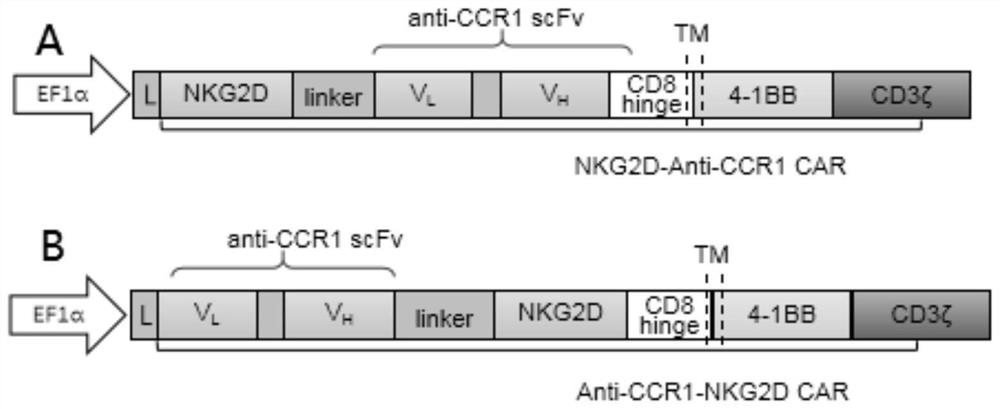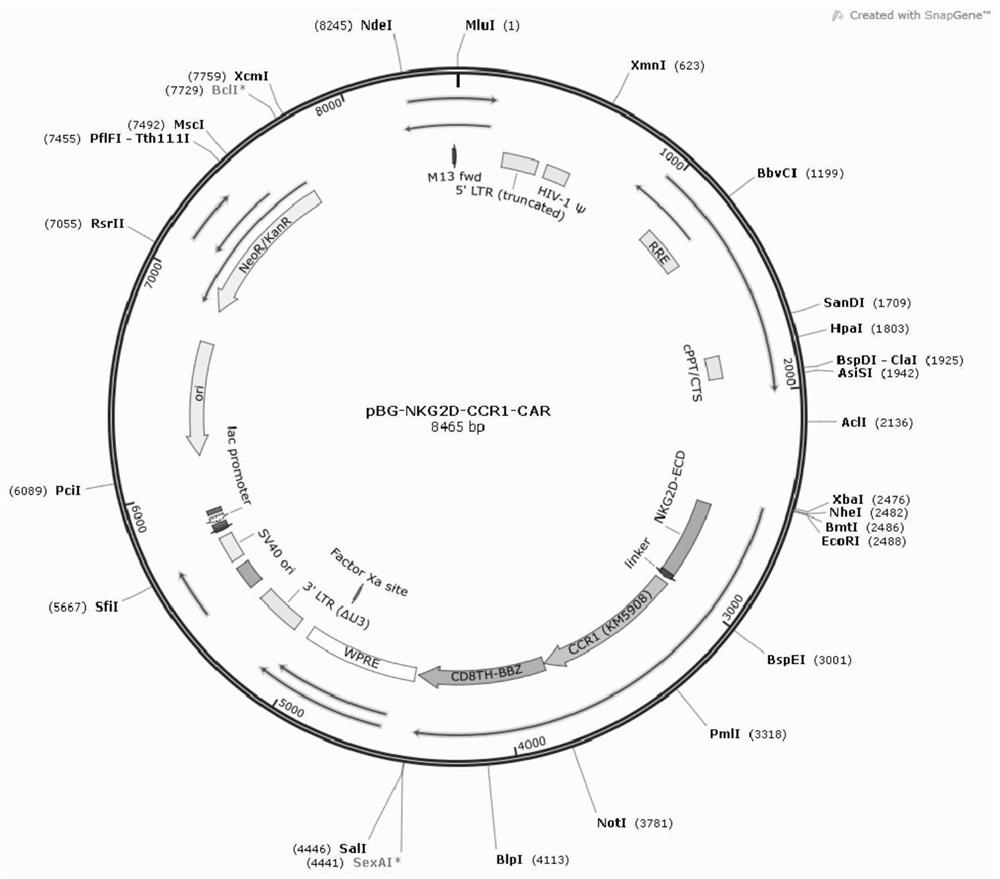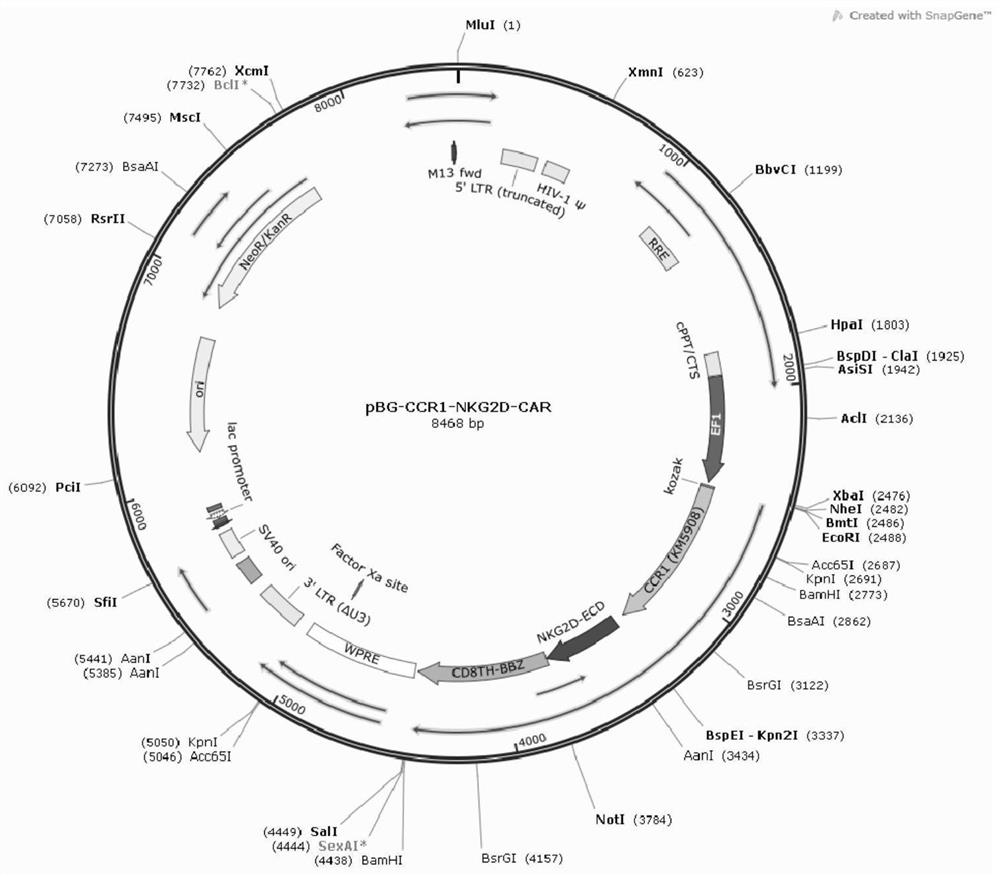Chimeric antigen receptors targeting Ccr1 and Nkg2d ligands and their applications
A technology of chimeric antigen receptors and ligands, which can be applied to polypeptides containing localization/targeting motifs, applications, retro RNA viruses, etc., and can solve problems such as affecting tumor treatment effects and large antigen escape
- Summary
- Abstract
- Description
- Claims
- Application Information
AI Technical Summary
Problems solved by technology
Method used
Image
Examples
Embodiment 1
[0059] Example 1 Vector construction
[0060] The structures of the two chimeric antigen receptors constructed in this example are as follows: figure 1 As shown, A is NKG2D-CCR1 CAR and B is CCR1-NKG2D CAR. According to the amino acid sequence of the chimeric antigen receptor, the whole gene was synthesized in Guangzhou Aike Biotechnology Co., Ltd. and constructed into a lentiviral expression vector. The vector structures of NKG2D-CCR1CAR and CCR1-NKG2D CAR are respectively as follows figure 2 and image 3 shown, the sequence information is shown below.
[0061] NKG2D-CCR1 CAR (sp-NKG2D-Linker-antiCCR1 VL-(G4S) 3- VH-CD8hinge-CD8TM-4-1BB-CD3Z)氨基酸序列:MDMRVPAQLLGLLLLWLRGARCLFNQEVQIPLTESYCGPCPKNWICYKNNCYQFFDESKNWYESQASCMSQNASLLKVYSKEDQDLLKLVKSYHWMGLVHIPTNGSWQWEDGSILSPNLLTIIEMQKGDCALYASSFKGYIENCSTPNTYICMQRTVGSTSGSGKPGSGEGSTKGDVVMTQTPRSLPVSLGDQASISCRSRQSLIHSNGITFLHWYLQKAGQSPKLLIYKVSNRFSGVPDRFSGSGSGTDFTLRISRVEAEDLGVYFCSQGTHVPPTFGGGTKLEIKGGGGSGGGGSGGGGSQVQLKQSGPGLVQPSQSLSITCTVSGFS...
Embodiment 2
[0065] Example 2 Detection of the expression of CCR1 and NKG2D ligands by tumor cells
[0066] First, CCR1 was detected by flow cytometry in U937, THP-1, HL60, KG1a, Jurkat, Daudi, RPMI8226, NCI-H929, Raji, and K562 cells after co-incubating with target cells with APC anti-human CCR1 Antibody (biolegend brand). expression. The result is as Figure 4 As indicated, U937, THP-1, RPMI8226 and NCI-H929 were CCR1 positive cells and HL60, KG1a, Jurkat, Daudi, Raji and K562 were CCR1 negative cells.
[0067] Target cells K562, NCI-H929, NCI-H929, U937 expresses antigen status. The result is as Figure 5 and Image 6 As shown, K562 cells negatively expressed CCR1, and NKG2DL, MICA, ULBP2 / 5 / 6 were positive; NCI-H929 cells were strongly positive for CCR1, and NKG2DL, MICA, ULBP2 / 5 / 6 were all negatively expressed; U937 cells were CCR1 positive, Positive expression of NKG2DL, ULBP2 / 5 / 6, negative expression of MICA.
[0068] Table 1 Expression of CCR1 and NKG2D ligand (NKG2DL) in tum...
Embodiment 3
[0070] Example 3 Preparation of anti-CCR1, NKG2D dual-target CAR-T cells
[0071] (1) Separation of PBMC
[0072] Collect 50 mL of peripheral blood; add 15 mL of lymphocyte separation solution to two 50 mL sterilized centrifuge tubes on the ultra-clean workbench, and slowly pour 25-30 mL of peripheral blood into the centrifuge tube containing lymphocyte separation solution. According to the instructions for use, centrifuge the centrifuge tube at 700g for 20min at room temperature, increase the speed by 1 and decrease the speed by 2. If the blood is stored for more than 2 hours, increase the centrifugation time to 30min;
[0073] After centrifugation, the blood is divided into 4 layers, consisting of plasma (upper layer), mononuclear cells between plasma and separating fluid (layer 2), separating fluid (layer 3), and red blood cells (bottom layer). The mononuclear cells were collected into a new centrifuge tube, 20 mL of PBS was added to dilute the cell suspension, and centrif...
PUM
 Login to View More
Login to View More Abstract
Description
Claims
Application Information
 Login to View More
Login to View More - R&D
- Intellectual Property
- Life Sciences
- Materials
- Tech Scout
- Unparalleled Data Quality
- Higher Quality Content
- 60% Fewer Hallucinations
Browse by: Latest US Patents, China's latest patents, Technical Efficacy Thesaurus, Application Domain, Technology Topic, Popular Technical Reports.
© 2025 PatSnap. All rights reserved.Legal|Privacy policy|Modern Slavery Act Transparency Statement|Sitemap|About US| Contact US: help@patsnap.com



